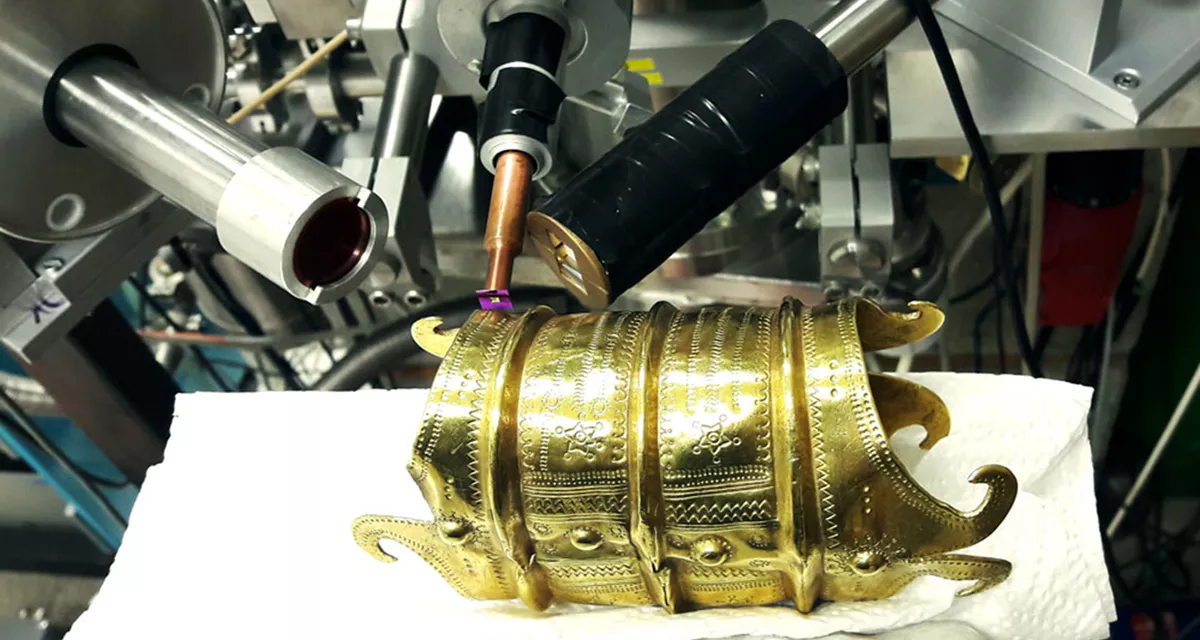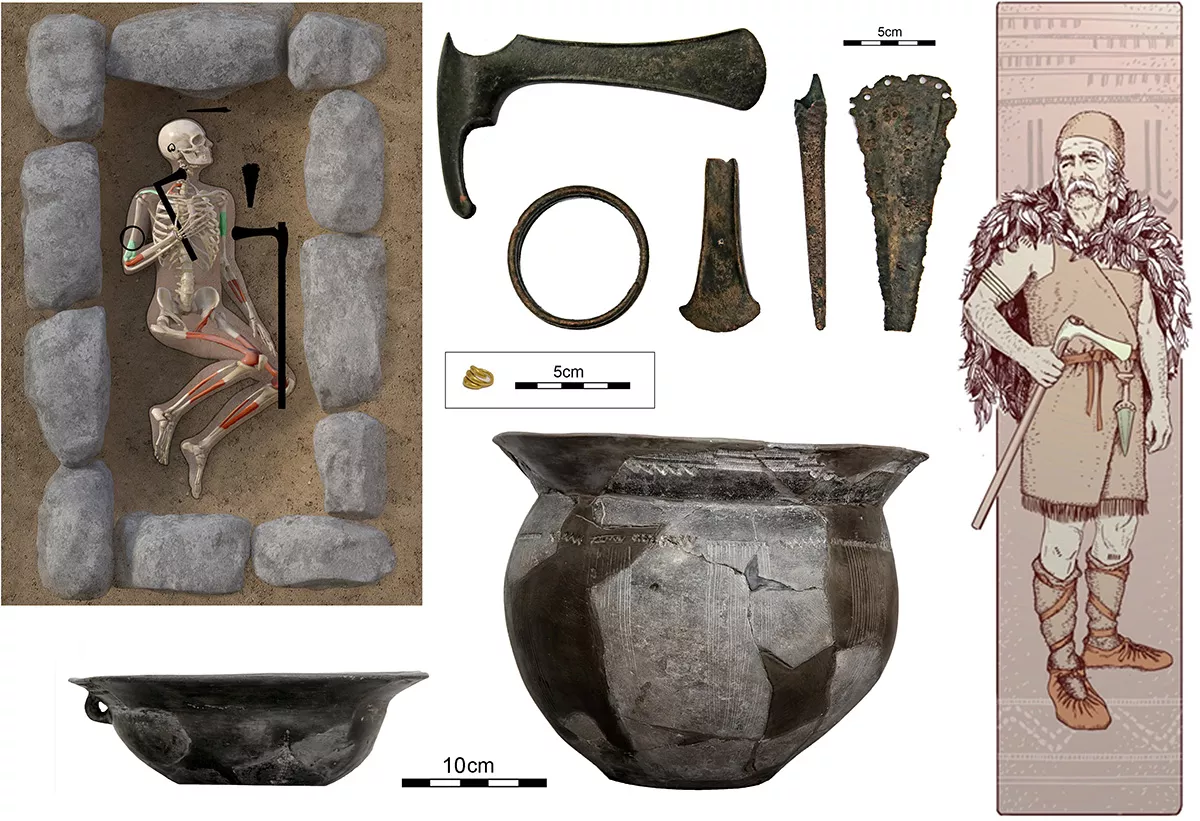The first five-year period of the ‘Lendület’ Mobility Research Group’s project, which has been operating within the Institute of Archeology of the ELKH Research Centre for the Humanities since July 2015, ended this year. The active work and the final report of the Research Group were rated as excellent by the professional reviewers, the special committee and the President's Committee for Scientific Evaluation.
The ‘Lendület’ Mobility project was set up to study settlements that were inhabited in the first thousand years of the Bronze Age in the Carpathian Basin between 2,500 and 1,500 BC, as well as burial sites and objects found there. This was done by integrating new types of scientific analysis that have become available in recent decades for interpreting archaeological finds. Research into this era has always focused primarily on examining the movement of communities, and this issue is gaining particular relevance in light of current migration phenomena.
In the absence of written sources, the existence and evolution of relations among communities living in remote areas of Bronze Age Europe were inferred in the past mainly from traditional archaeological analysis. However, the research team employed multidisciplinary methods hitherto not used in the research into this era – such as genetic, pathological, absolute dating, isotope geochemical and geophysical studies – which provided many new results for these thousand years, for instance about the people and small and large communities living in Hungary during the time of the builders of the great pyramids and the Greek heroes buried in mine graves in Mycenae.
The most important questions of the basic research carried out in collaboration with nearly 50 researchers – archaeologists, archaeogenists, anthropologists, materials scientists – were raised by the mobility and stratification of contemporary society, as well as the exploration of barter trade relations. To answer these questions, five well-researched settlements were selected from the central zone of the Carpathian Basin together with their micro-region, which represent a significant sample area for the study of Bronze Age communities in Central Europe and make a useful contribution to existing Bronze Age research.
The research team focused on three main topics. Among other things, they wanted to find out whether the analysis of human remains and objects could demonstrate the migration of larger communities and the extent of mobility at the time. This research was mainly focused on the strontium isotope sampling of the teeth of the deceased buried in inhumation (i.e. skeletal) graves (carried out in collaboration with Quinnipiac University and Yale University) and the analysis of samples taken from cremation graves in collaboration with an Italian research partner joining the research project of the Hungarian Academy of Sciences as a guest. The results showed that the communities of the first thousand years of the Bronze Age had a high degree of mobility and were also characterized by exogamy, that is, the habit of marrying outside the given group. As a result of the investigations, considerable progress has been made in the development of the strontium isotope map of Hungary, which provides data that can be used for other archaeological periods as well. The examination of funeral customs and diseases provides additional information on the lifestyles of contemporary communities.
-

- Multiple burials from Érd and an injury to a skull excavated in Füzesabony that can be related to combat.
(Source: Ferenczy Museum Center; Hungarian Museum of Natural History)
The archaic DNA studies conducted in collaboration with the Archaeogenetic Laboratory of BTK's Institute of Archeology and the Department of Genetics at Harvard University on the finds of the so-called bell-shaped vessels culture also show a high degree of mobility in connection with the individuals buried together with these objects, confirming that multidirectional mobility was likely to have characterized the period under discussion, which was different from the Neolithic migrations identified so far.
The research team also looked at how the new material of the era, the technology of producing bronze, emerged and where the raw materials used to make bronze objects in the area came from. In this context, the analyses carried out jointly with the Centre for Energy Research and the Wigner Research Center for Physics have led to important findings regarding the composition and production techniques of these objects. The results of lead isotope analysis prove that the Carpathian Basin was characterized by imports of copper ores of Balkan origin, and even more so by the import of finished objects, both in the Neolithic and Copper Ages. Similar studies carried out in collaboration with the Curt-Engelhorn Archaeometric Laboratory in Mannheim have shown that copper mines in the Garam region of Slovakia were cultivated, and ongoing tin isotope analyses suggest that the origin of the alloy essential for the production of bronze should be sought in the Czech-Saxon Ore Mountins and in the Balkan tin ore sources. Overall, the typological kinship of regional copper ore objects with devices from remote areas indicates broad interregional relationships.
Researchers also sought to find out how the use of bronze had changed the history of the Carpathian Basin and the surrounding area, and how the institutionalization of social inequality had emerged. Compared to the first half of the Early Bronze Age, a higher proportion of copper indicating social status could be observed later, and the appearance of tin-bronze tools and weapons was becoming more and more common. Studies supported by the Polish Science Foundation in collaboration with Adam Mickiewicz University in Poznań have clearly shown that amber finds from Bronze Age sites in Hungary are of Baltic origin. This suggests that controlling the trade in rare raw materials in Hungary during the Middle Bronze Age was probably a possible way to gain power. Studies carried out in the Heritage Science Laboratory of ATOMKI have revealed several sources of raw materials for gold objects.
-

- PIXE analysis of a gold armband at the Atomki Heritage Research Laboratory in Debrecen.
Based on the examination of the grave annexes indicating social status and the multi-level settlement system emerging in the period, it can be concluded that social inequalities became more significant in the later period and that social and economic systems of a different nature and structure were at work in the Carpathian Basin.
-

- Finds from the boss's grave in Balatonakali and the possible reconstruction of the buried man. (Photo: Péter Hámori, graphics: Zsolt Réti, Dávid Ringeisen)
As a result of the multidisciplinary activities of the research group, a partnership of outstanding significance was established within the research network of ELKH, which has contributed to the adaptation of new technologies, (for example, bioapatite-based radiocarbon testing of burnt bones in addition to collagen-based tests, and strontium isotope ratio measurements on ashes at ATOMKI) and to increase the competitiveness of domestic laboratories. New methods and international co-operations have made Bronze Age research in Hungary one of the leading research topics in Europe. The success is also well illustrated by the fact that the video recording of the research group's presentation at the international conference 'Genes, isotopes and artefacts' held in Vienna in December 2018 has been viewed nearly a thousand times on the YouTube channel of the OREA Institute of the Austrian Academy. In addition, a number of winning applications and international partnerships provided an additional opportunity for a deeper analysis of the Bronze Age period under discussion.
As well as the analysis of Bronze Age handicrafts, multidisciplinary conferences summarizing the multidisciplinary study of Bronze Age art and textile art, organized jointly with the BTK Institute of Archeology and the ‘Lendület’ Medieval Economy Research Group, also contributed to the research of broader historical and archaeological periods. Domestic and international workshops were held with a similar purpose to discuss the methodological issues of cremation burial research and the research results of Bronze Age ceramics.
During the five years of the project, more than a hundred publications were published (a total of 59 book chapters, books and studies, of which 21 were in Hungarian and 38 in foreign languages; 50 abstracts: 13 in Hungarian, 37 in foreign languages) in Nature, the Radiocarbon, Journal of Archaeological Science, Quarternary International, Acta Archaeologica Academiae Scientiarum Hungaricae and Communicationes Archaeologicae Hungariae, as well as 15 additional papers (6 in Hungarian and 9 in foreign languages) are expected to be published. In addition, 100 professional and educational presentations were given (a total of 54 lectures at 39 domestic events and 46 lectures at 31 foreign events). A volume of studies and several monographs in English are also under preparation, as well as a manuscript of an educational volume in Hungarian.
In addition to scientific research, the research group also considered the social utilization of knowledge as one of its key goals. Its website in Hungarian and English has been updated with nearly 100 bilingual scientific papers and research news articles over the past five years. The number of readers of their bilingual Facebook page is growing steadily: since its inception, they have shared the research team's news, brief educational studies and other information related to prehistoric archeology in more than a thousand posts to provide professionally verified and reliable knowledge of the European Bronze Age to the general public and professionals interested in this area of research.
The short film 'Bronze Age Mysteries', made in 2017 (downloadable from the BTK website), which presents the work of the research group and has been shown on television several times, and which represented Hungary at an archeological film festival, also contributed to the disseminatation of scientific knowledge.
The research group also participated in the production of another film within the framework of the European Union's CRAFTER (Crafting Europe in the Bronze Age and Today) program, which was launched in 2018 in collaboration with eight institutions from five European countries. The aim of the film 'In their Hands' is to introduce European Bronze Age pottery and help to revive modern handicrafts by the inspiration gained from it.